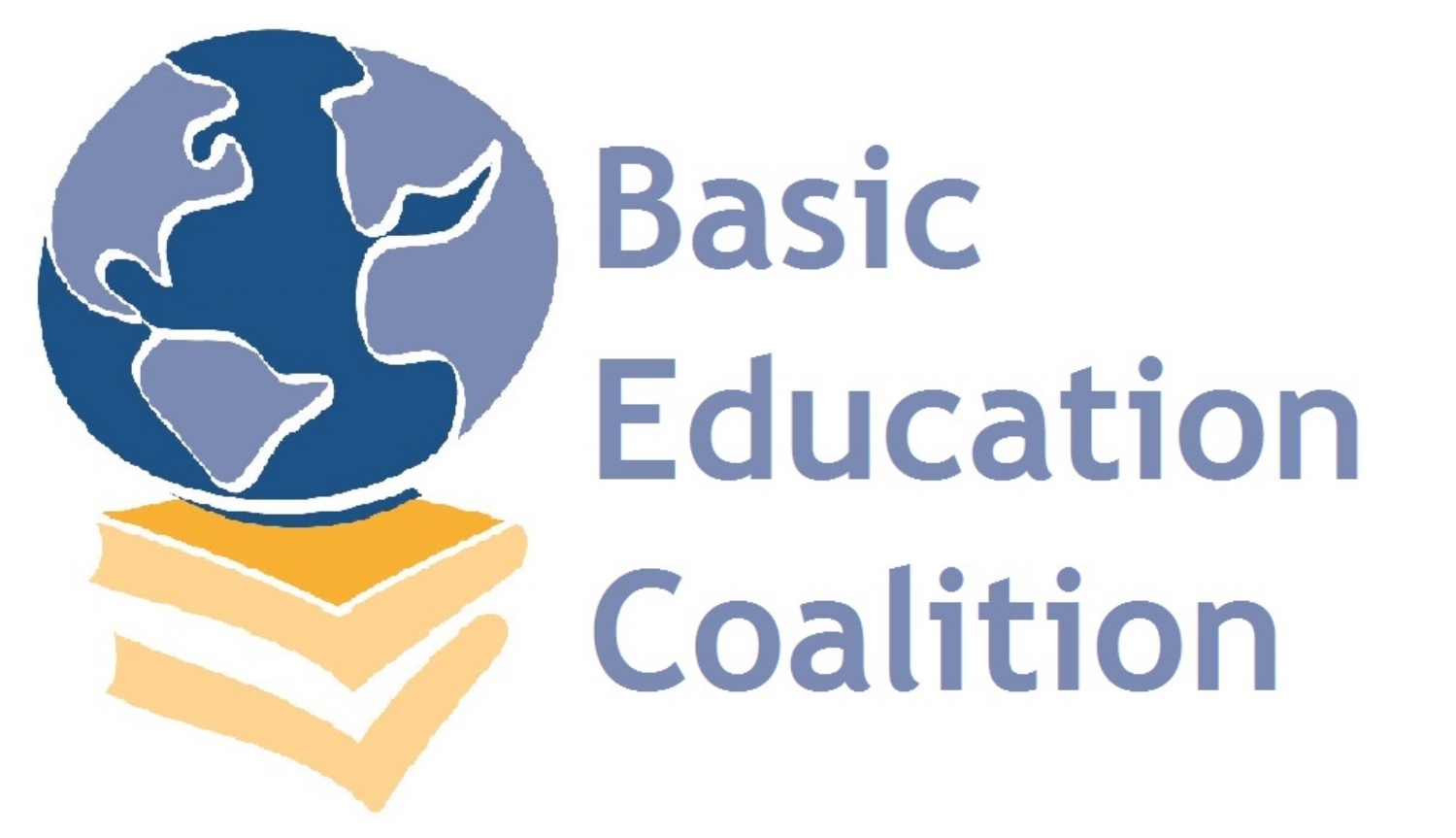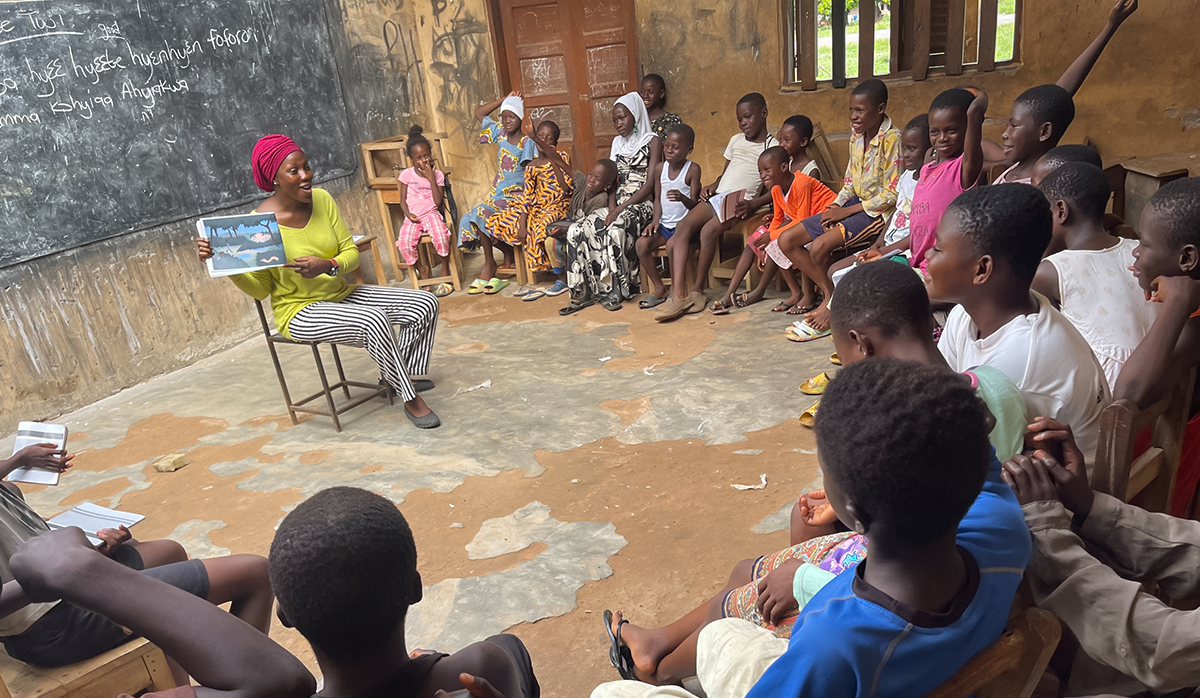By BEC member Luminos Fund
In a Luminos Fund classroom in Ghana, students gather in a circle around the Luminos Program Coordinator, Suwaida Aziz. Students eagerly raise their hands to answer questions as Suwaida leads the class through “Your Promise,” a story for Luminos students to help them understand their rights and what to do if they have any concerns. Today, students listen to the story of Alpha, a child who has learning difficulties and sometimes mixes up his numbers.
“Can we learn if we have trouble writing?” Suwaida asks the class, prompting a series of hands to fly in the air. This short story about Alpha emphasizes inclusive learning and celebrating children’s unique differences.
At Luminos, we have the privilege of supporting vulnerable children every day through our catch-up education programs in Sub-Saharan Africa and the Middle East. In just one year, the Luminos program helps formerly out-of-school children learn how to read, write, and do math through a joyful, activity-based curriculum. At the heart of our mission is a firm commitment to protect children from harm. In the Luminos program, we have a zero tolerance policy for abuse of any kind. Students’ well-being is a top priority. Not only is it a fundamental right of all children, but it also helps them to learn effectively.
“We not only teach and support students, but we also train and engage teachers, parents, and community members to ensure all students have a safe and inclusive environment and experience joyful learning,” says Corina Wornee, Luminos Global Safeguarding Lead and Liberia Senior Program Manager.
“By including the entire community, we ensure that everyone is more mindful of the well-being of their children. And Luminos is ensuring that learning is happening in a safe, joyful, and welcoming environment.”
Luminos takes a three-fold approach to ensure our student’s well-being: 1) safeguarding students’ welfare through extensive child protection training, 2) creating inclusive classrooms, and 3) supporting students’ health.
1. Safeguarding Student’s Welfare
We prioritize the well-being of our students by ensuring that staff are well-trained, students are educated about their rights, and there is a well-defined process to address any concerns. In all Luminos program locations, staff and teachers receive child protection and safeguarding training created by local and international specialists.
In these training sessions, we thoroughly review the Luminos Child Protection and Safeguarding Policy, covering topics such as child rights, classroom management, types of abuse, inclusive and gender-responsive teaching, and safeguarding with parents and the community. These sessions are designed to be interactive, providing teachers with frequent opportunities to apply new knowledge through case studies and role plays.
We also involve parents and community members as a holistic part of our child safeguarding strategy. Relevant topics are addressed in initial meetings with parent engagement groups before the school year starts and are woven into monthly meetings that teachers hold with parents throughout the year. Luminos strives to ensure all parents have a clear understanding of our safeguarding policy and their roles, and that they feel that the Luminos team respects their culture and rights to guide their child.
Finally, we make sure our students are educated about their rights so that they can build the confidence and skills to help protect themselves and their peers. Lessons are delivered throughout the year through a narrative format, using “Your Promise.” Lessons are reinforced throughout the year.
2. Inclusive Classrooms
All children learn best when they are happy. Ensuring all students feel included and able to fully participate in class is essential for providing a joyful learning experience. To that end, we prioritize inclusion in every facet of the Luminos program, from teacher recruiting and training to classroom instruction. Reinforcing the belief that all children are capable of learning is critical. We also train teachers in gender-responsive teaching and work with parents to support girls’ learning by addressing gender-related topics in our parent engagement meetings. Our pedagogy intentionally includes using multiple techniques to engage students and present information in a variety of ways, maximizing learning for all students, regardless of background and learning needs.
3. Healthy Students
We recognize that good health supports students in having enjoyable and successful learning experiences. Health information is often limited in the communities where we work, so Luminos integrates some health education into our daily curriculum. Topics include common diseases, hygiene, nutrition, the human body, and substance abuse, among others. In places where there is significant food insecurity, Luminos also provides a free hot lunch to our students, helping them stay healthy, concentrate better on their lessons, and serving as an additional incentive for enrollment and attendance.
Through this three-fold approach, we prioritize our students’ safety and well-being, allowing them to fully engage in our classrooms and experience joyful learning firsthand.
“Placing student welfare at the center of everything we do is part of Luminos’ DNA,” Corina notes. “It is only after ensuring students feel safe and included that joyful learning can occur, allowing students to build foundational reading, writing, and math skills.”
To learn more about Luminos’ approach to making learning joyful in our classrooms, explore the full Joyful Learning element of the Luminos Method!
About the Luminos Fund:
The Luminos Fund is an international education nonprofit that provides transformative education programs to thousands of out-of-school children, helping them to catch up to grade level, reintegrate into government schools, and prepare for lifelong learning. In just one school year, we teach students to read and do math – to learn how to learn – through a joyful, activity-based curriculum.

